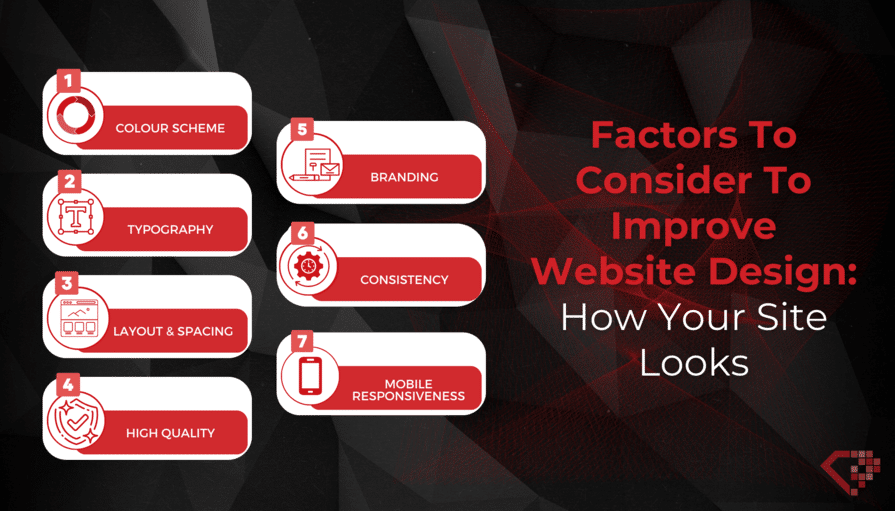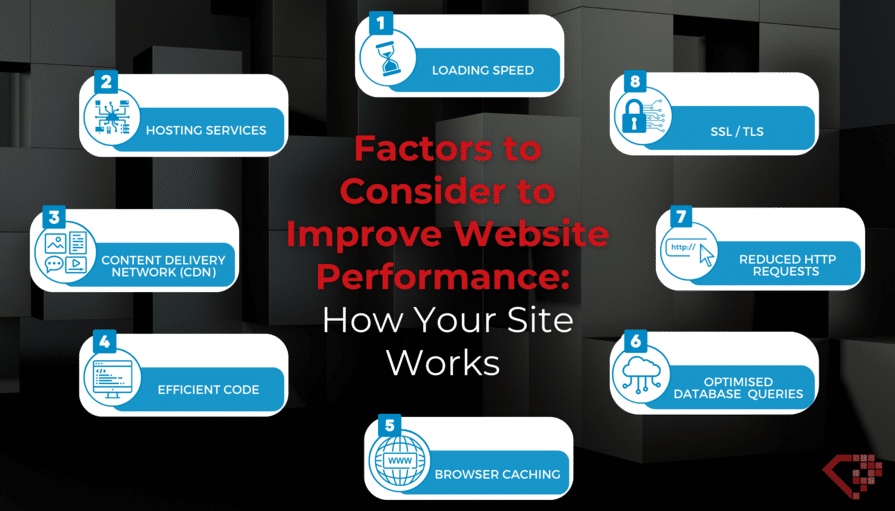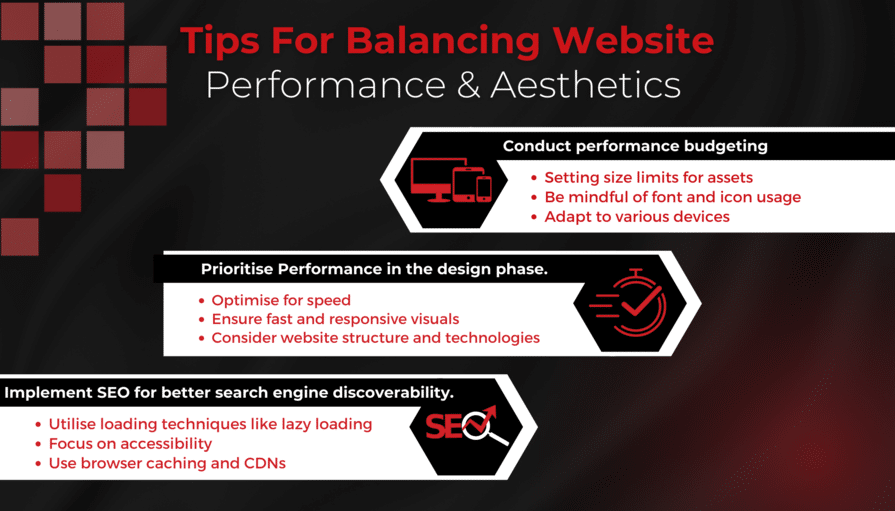In terms of web design, it’s important to balance two key things: how your website looks (aesthetics) and how well it works (performance). A website can look beautiful, but that doesn’t always mean it will work well. Similarly, a website that’s very basic in design isn’t always a sign of great performance.
The way a website looks and works are closely connected. A good-looking website can draw people in, but if it’s slow or hard to use, they won’t stay for long. On the other hand, a website that works really well is great, but if it doesn’t look appealing, people might not be interested in it in the first place.
Finding the right mix of good looks and strong performance is key. In this blog, we’ll explore different ways to do this. We’ll show you how to increase website performance without sacrificing visual appeal, while also creating a website that’s fast and user-friendly.
Factors to Consider to Improve Website Design and Performance
Let’s break them down into two categories: aesthetic factors (how your site looks) and performance factors (how your site works). It’s also worth noting that how well your website performs in these areas can impact its SEO (Search Engine Optimisation) performance.
Search engines like Google consider site speed, mobile responsiveness, and other performance metrics when ranking websites. So, a well-balanced website in terms of both aesthetics and performance not only provides a better experience for your visitors, but also helps improve your site’s visibility on search engines.
Aesthetic Factors:
- Colour Scheme: The colours you choose for your website can really set the mood and grab attention. It’s important to pick colours that go well together and reflect your brand.
- Typography: This is all about the fonts you use. The right font can make your website easy to read and give it a professional look.
- Layout and Spacing: How you arrange the content on your site matters. A clean layout with proper spacing makes your site look organised and helps visitors find what they need easily.
- High-Quality: Using high-quality images and graphics makes your site look more professional and appealing.
- Branding: Your website should reflect your brand’s identity through its design. This includes your logo, colours, and overall style.
- Consistency: Keeping a consistent style throughout your website helps in making it look polished and professional.
- Mobile Responsiveness: With so many people using their phones to browse the web, it’s important that your site looks good and works well on all devices, especially smartphones and devices with smaller screens. Using a website performance optimisation tool can help you test this.

Performance Factors:
- Loading Speed: A fast-loading website is essential. If your site takes too long to load, people might leave before they even see it.
- Hosting: Good hosting can make a big difference in how well your website performs. It’s well worth investing in a reliable hosting service.
- Content Delivery Network (CDN): This helps speed up loading times by storing copies of your site at different locations around the world.
- Efficient Code: Clean, well-written code can help your website run more smoothly and quickly.
- Browser Caching: This helps your website load faster for returning visitors by storing some of your site’s data on their browser.
- Optimised Database Queries: Making sure your database is well-organised and efficient helps in faster data retrieval, improving site performance.
- Reduce HTTP Requests: The fewer requests your website makes to the server, the faster it will load.
- SSL/TLS: Using SSL/TLS not only makes your website more secure, but also can improve its performance.
By paying attention to these aesthetic and performance factors, you can create a website that not only looks fantastic but also runs smoothly and efficiently. More on that next!

Tips for Balancing Website Performance and Aesthetics
Start creating the website with performance in mind. When designing a website, it’s important to prioritise performance from the outset. This means considering how the website will be structured, what technologies will be used, and how the website will be optimised for speed. By starting with performance in mind, you can ensure that your website is fast and responsive from the very beginning.
Optimise your visuals and images. Visuals and images are an important part of any website, but they can also slow down your website’s performance if they’re not optimised correctly. To ensure that your website is fast and responsive, it’s important to optimise your visuals and images by compressing them, reducing their file size, and using the right file format.
Use a responsive design when creating a website. Responsive design is a design approach that allows websites to adapt to different screen sizes and devices. By using a responsive design, you can ensure that your website looks great on all devices, from desktop computers to smartphones and tablets.
Implement best practices for performance. There are many best practices that you can implement to improve your website’s performance. These include using a content delivery network (CDN), minifying your code, and using browser caching.
Be selective with fonts and icons. Fonts and icons can add a lot of visual interest to your website, but they can also slow down your website’s performance if they’re not used correctly. To ensure that your website is fast and responsive, it’s important to be selective with your fonts and icons and to use them sparingly.
Implement loading techniques for assets and web pages. Loading techniques such as lazy loading and asynchronous loading can help to improve your website’s performance by reducing the amount of time it takes for your website to load. By implementing these techniques, you can ensure that your website is fast and responsive, even when it contains a lot of assets and web pages.
Conduct performance budgeting (file sizes). Performance budgeting involves setting limits on the size of your website’s assets and web pages. By setting these limits, you can ensure that your website is fast and responsive, even when it contains a lot of content.
Utilise browser caching and CDNs. Browser caching and CDNs can help to improve your website’s performance by reducing the amount of time it takes for your website to load. By utilising these technologies, you can ensure that your website is fast and responsive, even when it contains a lot of assets and web pages.
Implement accessibility and SEO. Accessibility and search engine optimisation (SEO) are important considerations for any website. By implementing accessibility features such as alt tags and captions, you can ensure that your website is accessible to all users, including those with disabilities. By implementing SEO best practices such as using keywords and meta descriptions, you can ensure that your website is easily discoverable by search engines.

In Closing
Creating a website that’s both visually appealing and performs well takes a bit of forward planning. We’ve explored how the right mix of aesthetics – including colour scheme, typography, and layout – combined with performance factors like loading speed, efficient coding, and responsive design, can make your website stand out. Remember, a website that looks great but performs poorly, or vice versa, won’t provide the best experience for your visitors.
Designing and developing for performance can also enhance user experience, improve your SEO rankings, and ensure accessibility for all users. From optimising visuals and images to implementing browser caching and CDNs, each step is crucial in building a website that meets the needs of both your business and your audience.
If you find yourself needing a bit of help to get this balance right, don’t worry – Ruby Digital is here to assist you. Our team of web design and development experts specialises in crafting websites that not only look stunning but also perform exceptionally. We also offer WordPress development and WordPress site maintenance services.
Whether you’re starting from scratch or looking to improve an existing site, we’re ready to help you create a digital presence that truly reflects the quality of your brand. Reach out to Ruby Digital today, and let’s create a website that perfectly combines aesthetics with performance – a website that’s not just a digital space but a powerful tool for your business!



